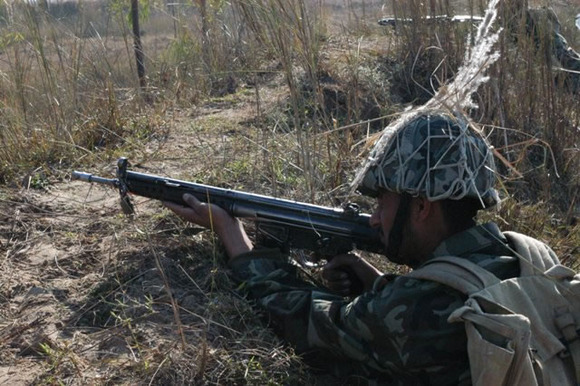
By Pakistan Armed Forces
Days after India and Pakistan reached a ceasefire agreement, uncertainty persists regarding the future relationship between the two South Asian neighbours.
On the morning of 7 May, India launched air strikes targeting sites in Pakistan and the Pakistan-administered region of Kashmir. This was in response to a deadly militant attack on tourists in India-administered Kashmir. Islamabad has denied any involvement in the attack.
What followed were four days of intense cross-border shelling and aerial violations between the two nuclear-armed countries, culminating in a surprising ceasefire announcement on Saturday. However, despite the ceasefire now entering its fourth day and life gradually returning to normal in towns along the Line of Control, tensions between the two nations remain high and far from resolved.
Just days before initiating the military operation, India announced a series of diplomatic measures targeting Pakistan. These included suspending the Indus Waters Treaty (IWT), halting the issuance of most visas, and terminating all trade between the two countries.
Pakistan swiftly retaliated with its own set of countermeasures. These included suspending visa issuance for Indian nationals, imposing a trade embargo, and closing its airspace to all Indian flights. So far, none of these retaliatory actions by either side have been reversed. Here is the current situation between the two neighbours following the Pahalgam attack:
Suspension of Indus Waters Treaty
On Monday, during his first public statement following the airstrikes, Indian Prime Minister Narendra Modi declared, “India’s stand is absolutely clear – terror and talks cannot go hand in hand. Water and blood cannot flow together.”
His comments align with reports suggesting that the Indus Waters Treaty, a pivotal water-sharing agreement between India and Pakistan, remains suspended. The IWT, brokered by the World Bank in 1960, governs the allocation of water from six rivers in the Indus basin. It has withstood two wars between the nations and had long been seen as a model for trans-boundary water management – until its suspension late last month.
Pakistan’s Prime Minister Shehbaz Sharif has maintained that he believes the water dispute can still be resolved through peaceful diplomacy. However, India’s unilateral decision to suspend the treaty represents a significant diplomatic escalation.
Pakistan heavily relies on these rivers for agricultural irrigation and drinking water. “Water cannot be weaponised,” Pakistani Finance Minister Muhammad Aurangzeb told Reuters on Monday, asserting that India’s unilateral suspension of the treaty “has no legal basis.”
Experts say India currently lacks the massive infrastructure needed to retain or divert the tens of billions of cubic metres of water from the western rivers during high-flow periods. But if India begins to control the water flow using its existing and future infrastructure, the impact on Pakistan would likely be felt during the dry season.
In response to India’s actions, Pakistan threatened to suspend the 1972 Simla Agreement – which created the Line of Control. However, it has not yet followed through on that threat.
Suspension of Visas and Diplomatic Expulsions
As part of its retaliatory measures, India scaled back its diplomatic presence in Pakistan. It expelled all Pakistani defence attachés, labelling them “persona non grata,” and announced that Indian defence advisers would be withdrawn from Islamabad.
Pakistan issued a reciprocal response by reducing its diplomatic staff in India. Both nations have suspended nearly all types of visas for each other’s citizens.
Border Closures
India and Pakistan also closed the Attari-Wagah border crossing – the only land entry point between the two nations. This crossing, which requires special permits, is often used by individuals visiting family members, attending weddings, or reconnecting with loved ones.
Initially, both countries gave their citizens about a week to cross the border and return home, but that deadline was later extended. Despite this, the closure led to emotional scenes at the border as families were separated and some individuals were unable to return.
Additionally, following the 7 May strikes, India announced the closure of its end of the Kartarpur Sahib Corridor. This corridor allowed Indian Sikh pilgrims visa-free access to one of Sikhism’s holiest sites in Pakistan.
Between 2021 and 2023, nearly 200,000 Indian pilgrims visited the Kartarpur shrine. Current figures have not yet been disclosed. Indian Foreign Secretary Vikram Misri stated that the suspension of access to Kartarpur would remain in effect “until further notice.”
Airspace Restrictions
As a part of its countermeasures, Pakistan closed its airspace to all Indian flights, both military and civilian. India responded with similar restrictions against Pakistani flights.
These measures have forced international airlines to take longer and more expensive detours, increasing travel time and fuel consumption.
Trade Suspension
All forms of direct and indirect trade between the two countries have been suspended. The impact on India is expected to be limited, given its minimal imports from Pakistan. However, for Pakistan, the effects are more severe.
Facing high inflation and a struggling economy, Pakistan stands to lose access to vital trade routes and essential goods from India, including medical supplies and raw materials.
As the fragile ceasefire holds, the wider diplomatic fallout continues to unfold. Whether these measures signal a long-term breakdown or are temporary retaliatory acts remains uncertain. But for now, the border remains sealed, diplomatic ties are frayed, and tensions between the two neighbours are far from over.




